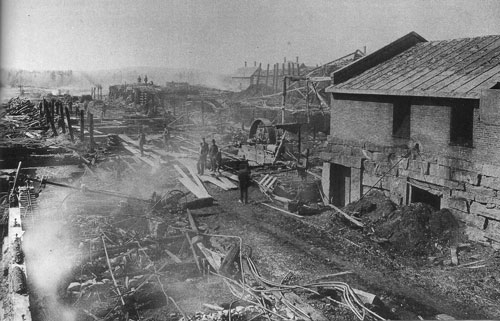B A C K T H E N
Morning After the Night Before

Lincoln, April 1899. A.L. Weatherbee wrote in his diary:
The tannery whistle is blowing the signal of fire, and the tannery is all in flames. 1.30 A.M., tannery burned… It is a beautiful moonlight night, calm and warm, no wind and what there is comes from the northeast. Everything is favorable for a fire of this kind at this place. Carload of leather on tracks saved. No bark burned, many hides removed. Cause of fire unknown. James McHugh and Peter Whalen night watch. When whistle blowed tannery was in flames…
Don’t believe tannery will ever be rebuilt. It has served its purpose and now presumably robed in many fire insurance policies, it goes up in smoke, leaving behind as mourners the poor wage earners, the Merchants who supplied them, and the farmer who has parted with his hemlock for a song, and the town generally with her extra burden of paupers.
Purification by fire sometimes coincided with the exhaustion of the tannery’s bark resource, but at best, a tannery was a conflagration waiting to happen, as fires in the dusty bark mills occurred without aid of firebug or proprietor. The Lincoln tannery, along with others at Medway, Winn, and Lowell, had been a reeking jewel in the crown of H. Poor & Son. In 1893 the mills had become part of the United States Leather combine.
Sole leather was sold by the pound, the object being to induce the hides to soak up as much tannin as possible. Newly arrived hides (most were from the River Plate), dry and flinty, were soaked, split, and placed in the hide mill, a machine that would have delighted the Grand Inquisitor as it beat the hides with spiked timbers and subjected them to a constant drip of water.
The hides, softened up, but far from fully recanted, were given a week or so to reflect while hanging I the reeking sweat pits, where putrefaction loosened the hair and scruff. Sweating hides had to be carefully watched lest they get overdone—a thunderstorm greatly advanced the process. After another lively beating the now thoroughly demoralized skins were sent to the “beamsters,” skilled workers armed with big, razor-sharp knives, who scraped, trimmed, and shaved the decomposing dermis. The beamsters suffered as well—raw-rubbed forearms became easily infected; hair under fingernails created festering sores that caused the nails to drop off. The sickening stew of putrefying trimmings, fat and hair, along with exhausted liquors, was poured into the adjacent waterway.
The trimmed hides were now ready for the vats, wherein, over a period of from four months to a year, they were soaked in progressively stronger liquors, leached from the ground bark. Tanned hides were drained, scrubbed, treated with fish (pogy) oil, hung, and rolled—rolling, another skilled job, compacted the surface. The rollers, like the beamsters, affixed their mark to each side, and were fined for poor work. The finished leather was marketed by Boston agents.
A dispatch stated that the great Church tanneries, at Beddington, were totally destroyed by fire on Thursday night; the fire starting in the bark mill… The insurance on the plant was $30,000… The Church tannery had a rather checkered career… Of late it had been thought that the tanneries have not been profitable. —The [Bangor] Industrial Journal, Oct. 2, 1896.
Text by William H. Bunting from A Days Work, Part 2, A Sampler of Historic Maine Photographs, 1860 - 1920, Part II. Published by Tilbury House Publishers, Gardiner, Maine. 800-582-1899
